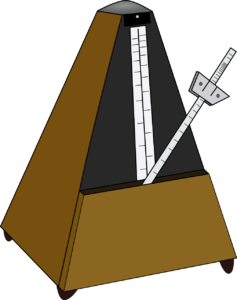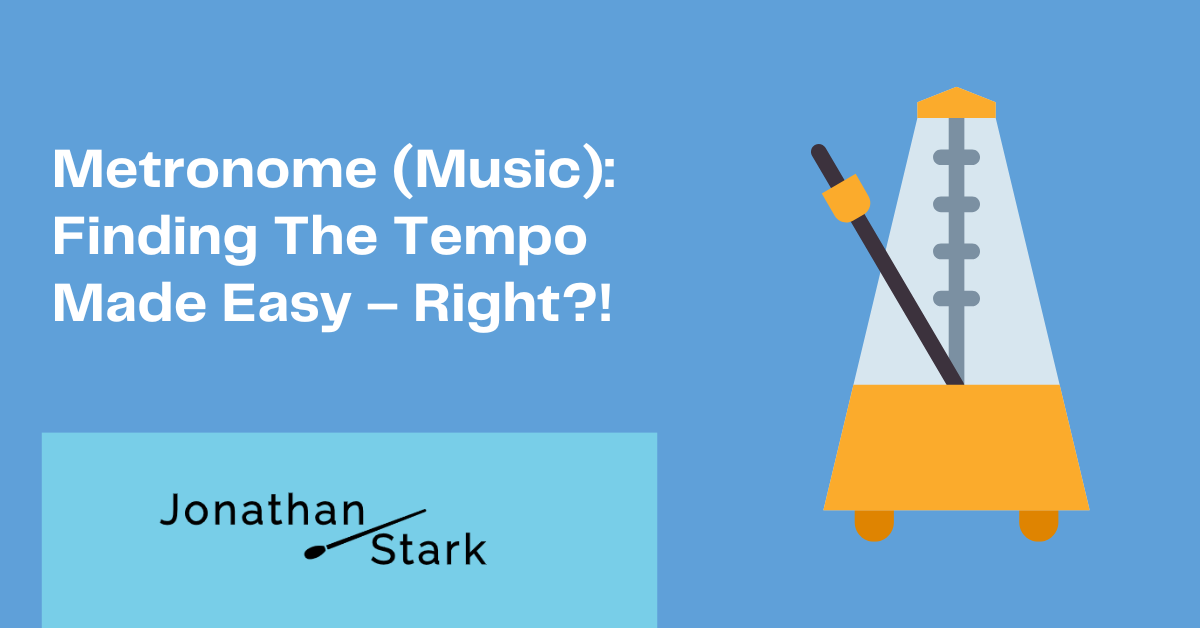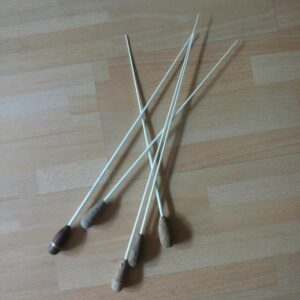A metronome is a device that can be used to indicate the tempo of a piece of music. In the past, metronomes worked exclusively mechanically, but today they are mostly electronic. A metronome is often built into electronic musical instruments such as keyboards or electric pianos, but is also available online or as an app.
What you will read in this article:
Few aspects influence the effect of a piece of music as much as the tempo. The question of how to choose the “right tempo” of a piece of music was therefore discussed early on in music history.
Now one might think that the metronome would be the answer to this question. With a device that can precisely indicate a musical tempo, tempo selection is easy, right?
In fact, the opposite has happened. Ever since the metronome made precise tempo measurement and indication in music possible, the controversy over choosing the “right tempo” has, if anything, intensified.
More on this later in this article. First, it must be made clear how a metronome works and in what context it was invented.
What does a metronome do?
A metronome emits acoustic pulses at regular time intervals. These evenly spaced acoustic pulses are the landmarks for a constant tempo.
On a metronome, you can set a specific number. This number indicates how many pulses the metronome provides per minute. The unit of measurement is accordingly called “beats per minute” and is abbreviated as “bpm”.
The bpm number is combined with a specific note value. For example, the metronome specification ♩ = 120 means that a quarter note is exactly as long as a pulse if the metronome provides 120 pulses per minute (i.e. half a second).

About the history of the metronome
The metronome was invented at a time when a centuries-old musical tradition was gradually disintegrating. Until about 1800, it was common for musicians to just “look” at a piece of music to determine the correct tempo. Time signature, note values, harmonic rhythm and character of the piece were tempo-determining. Supplementary tempo indications were limited to general phrases such as Andante (walking) or Presto (fast).
From about 1800 on, this was no longer precise enough for musicians. Tempi should be indicated in a way that they could be understood everywhere without misunderstanding. So scholars all over Europe set to work.
The metronome was the result of this work. It came into being in the years 1814/1815 as part of a veritable musical thriller. Two inventors, Dietrich Nikolaus Winkel and Johann Nepomuk Mälzel, were involved in a legal dispute over who owned the rights to the metronome.
You can read about this musical thriller in the Summer 2022 Mini-Experience.
Then choosing the "right tempo" is quite easy, isn't it?
At the beginning of the article I hinted that one could now make a careless consideration: You just have to stick to the metronome indication and you will automatically play every piece in the right tempo.
This is not quite correct. Although the metronome has existed for a long time, there is still a debate about the “correct” tempo of musical pieces. This has to do with several aspects.
Many pieces do not have metronome markings
The most obvious aspect is that not every piece in the classical repertoire has a metronome indication. As already described, the metronome was invented only in the years 1814/1815; all pieces of music written before then logically do not have metronome markings.
This applies, for example, to all compositions by Mozart, Bach, Handel and many other composers! Even Beethoven, who was enthusiastic about the metronome, only added metronome markings to about 40 of his approximately 250 compositions afterwards.
Thus, for pieces written before 1814/1815, one still has to choose the tempo without a metronome. The choice is based on technical aspects such as time signature, note values and harmonic rhythm, but also on traditions (for example dances) and the character of the piece.
The room
Even when there is a metronome indication, there may be good reasons to intentionally resist it. One such reason is the room in which a piece is played.
If you are playing in a room with a lot of reverberation (for example, a church), you might choose a slightly slower tempo so that the music doesn’t “blur.” On the other hand, if you play the same piece in a room with particularly dry acoustics, you might choose a slightly faster tempo in order to avoid “sound holes”.
Whether one should adapt the tempo of a piece to the room is, by the way, a matter of dispute among conductors. Hans Swarowsky (a renowned 20th century conducting teacher), for example, thought nothing of it.
A metronome sets a constant tempo
Since the metronome provides acoustic impulses at regular intervals, it gives a constant tempo. But in music, there are so many places where the tempo changes – it slows down (ritardando) or speeds up (accelerando) over a certain distance.
In such stepless tempo changes, the metronome is not much help. However, modern metronomes now have the function to program certain tempo progressions.
The "right tempo" in opera
The matter of the “right tempo” is particularly tricky in opera. There, one has to deal with singers who often sing the same role on several evenings per week. However, the voice does not “work” equally well every day. It depends on external influences and the singer’s personal condition at a particular time.
This is what distinguishes the human voice from a piano, for example, which always reliably emits the same tone as soon as the corresponding key is pressed. Whether the pianist is having a bad day or it is snowing outside is irrelevant. You press the key, the sound comes.
But you have to adjust to working with the voice every day – and that naturally affects the tempo. In opera, it’s the conductor’s job to “sense” the singers’ personal condition each evening and adjust the tempo accordingly.
The tempo may be a little slower on one evening and a little faster on another. To “whip through” a tempo just because the metronome demands it would quickly lead to a fiasco in opera.
Conclusion
The metronome is a helpful invention, but should not be used unthinkingly when making music. Metronome indications are helpful as a point of orientation, but do not release the performer from having to think about the tempo himself.

Jonathan Stark – Conductor
Hello! I'm Jonathan Stark. As a conductor, it is important to me that visits to concerts and operas leave a lasting impression on the audience. Background knowledge helps to achieve this. That's why I blog here about key works of classical music, about composers, about opera and much more that happens in the exciting world of music.



